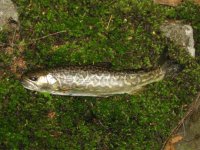ryansheehan
Well-known member
- Joined
- Jun 1, 2015
- Messages
- 2,520
I meant to post this on memorial day weekend but I'm a slacker. My 12 year old son has really got into fly fishing. We hit the lower savage and he got into some great dry fly action. As I was getting the net ready (my new job) I noticed it looked a little different and low and behold it was a tiger trout. Looking at the fish my first instinct was that it was stocked based on its tail. Then I started second guessing myself. Maryland doesn't stock tiger trout or the lower savage. West Virginia does stock tigers I believe but this fish was at the very top of the river, above the PHD pool. There would be a couple of pretty tough blockages to swim up from the North Branch this far. In all my hours of fishing the Savage I've never caught a tiger or heard of anyone catching one. Will post a pic shortly, he and I are headed back out tomorrow morning can't wait!







